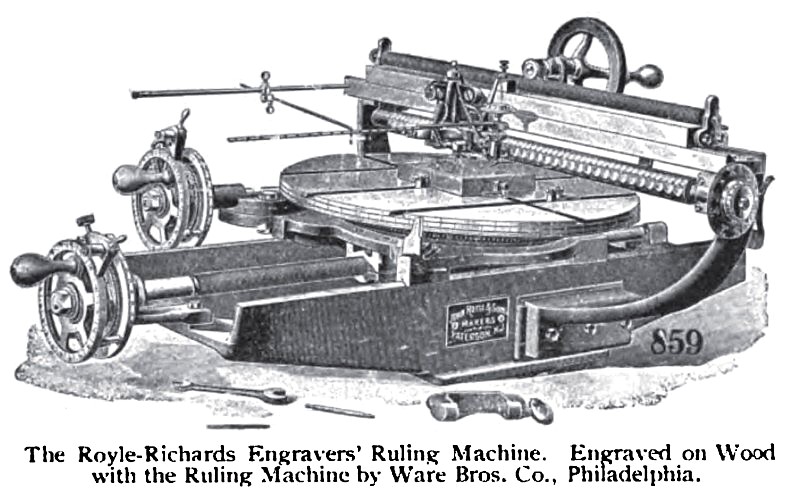Image
|
Title: |
1906 Article-John Royle & Sons, Ruling Machine |
|
Source: |
Camera Craft, Oct 1906, pg. 408 |
|
Insert Date: |
11/26/2012 9:57:14 AM |
Revival of Wood Engraving
Process work some years ago took possession of magazines and newspapers, and it was supposed that wood engraving was a thing of the past. The wood engravers were mostly absorbed by process engraving establishments, and were employed in trimming and re-touching photo-engraved plates. The public looked upon the art of the wood engraver as something belonging to the past generation, and imagined that in a few years it would be counted among the lost arts.
Fortunately, there were a few conservatives, and all the wood engravers did not go out of business, in spite of the small encouragement they received. Recently a change has been going on in public opinion. People are awakening to the fact that while process work has a wide field all to itself, and while it is unapproachable in that field, it has certain limitations, and cannot take the place of the wood block. Wood engraving also has a field of its own, and because of certain peculiar advantages, which are unique, it has in its way no rivals. Artistically, it holds a place shared only by the mezzo-tint. Its effects are produced by putting white upon a black ground—that is, as the engraver works he cuts away what would otherwise be black. This is the opposite of what is done in making a pen or wash drawing, where the artist is constantly adding black to his design. Of course the process block is merely a reproduction of his work. Pen drawings are particularly weak, and light in effect because the work is done in the blackest of ink; there is an inherent difficulty in obtaining strength in this mode of drawing. Wood also has another advantage in the use of a white as well as a black line. Properly handled, the wood block presents almost unlimited possibilities to the artist. When to these artistic features we add certain commercial advantages of the greatest importance, we get a glimpse of the reason why wood still persists. The engraved line is sharp, clean and has smooth sides, nearly vertical, which reproduce perfectly by electrotype, and without any difficulty. So perfect is the reproduction that no one ever dreams of using the wood block in the printing press. The printing surface is perfect, and has ample depth, which gives another point of advantage. The wood cut is at its best upon uncalcndered paper, and with ordinary paper, ink and printing, still produces clean, vigorous impressions. It gives the printer the least trouble. It is not a matter of wonder that renewed attention is now being given to the art. Wood engravers are busy, and there is really a revival of business among them.
We have mentioned these facts to explain to our readers the appearance of a new engravers' ruling machine, the Royle Richards, a catalogue of which is just at hand. On the death of Mr. Richards, the firm of John Royle & Sons came into possession of all his papers, drawings and patterns of the ruling machine. They have re-designed it, added new features, and by means of modern machinery have vastly improved the workmanship, making a new instrument of it. The catalogue is a large and handsome piece of bookmaking from the University Press. There are two half-tones, the remainder of the cuts, nearly forty in number, are from electrotypes of wood cuts. The subjects are all mechanical except those devoted to illustrating the tints and line work, which the machine can produce. Some sixty different tints, lines and combinations are shown, and these appear to be only a fraction of the possible varieties. The work produced is so varied that "Engraving Machine" suggests itself as its proper name. Some of the engravings of complicated machines were made with only a trivial amount of hand work. The machine is really indispensable to the wood engravers. From examples that have been given, it appears that it would be extremely useful to the process workers for backgrounds, skies, flat tints, and many other effects. Certainly, when hand tooling is used to any extent, the machine, in the hands of a man who cared to make the most of it, would become invaluable. It can work upon wood, copper, zinc, brass, and for the wax process can do any of their ruling work. The steel engraver will find it useful in working through etching grounds. The accuracy of the machine is great. Parallel lines may be ruled as fine as 4,320 per inch. On full size machines the circle can be divided into 129,600 parts. Smaller machines divide the circle into 64,800 parts. This is a number sufficiently great for all practical purposes. The real advantage of these very fine graduations is not in the fact that one ever wishes to make use of such fine rulings, but because by the use of them almost any subdivision of the inch may be obtained with an even number of teeth. |
|
 1906 John Royle & Sons, Ruling Machine
1906 John Royle & Sons, Ruling Machine
|
|
|
|